



Moviendo carga para impactar al mundo Moving cargo to impact the world Gaviria Investments Corp
SERVICIOS:
Movimiento de carga de trasbordo, importación, exportación, y reexportación entre las diferentes terminales portuarias de Panamá. Servicio especializado, personalizado y eficaz a cada uno de nuestros clientes.

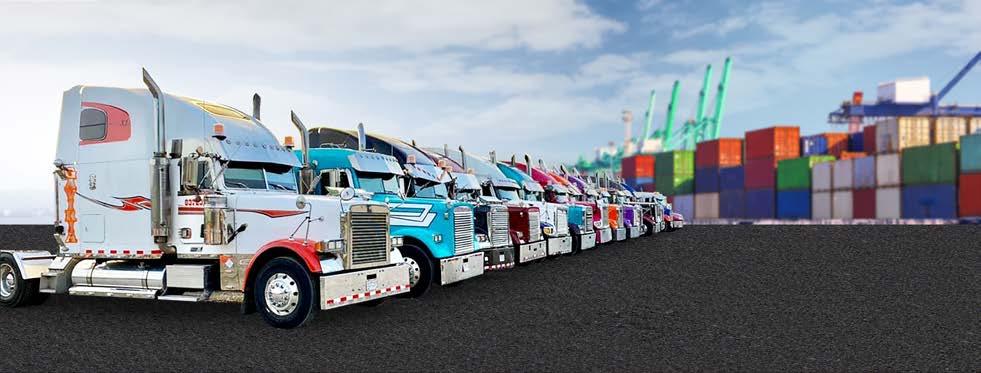
Contamos con oficinas en Panamá Pacífico, ciudad de Colón y en los puertos PSA y Balboa. Patios propios de contenedores, talleres de mantenimiento con personal altamente calificado. Personal experto en el manejo de todo tipo de carga.
Sede Panamá Pacifico
PERSONAL TRAINING • TRUSTED • FAST • PERSONAL TRAINING • TRUSTED • FAST
International Business Park,
oficina
Emails: info@gaviriacorp.com/logistica@gaviriacorp.com
Edificio 3835,
105

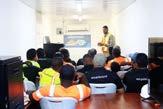

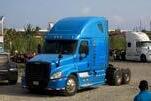

SEGURIDAD RAPIDEZ ENTRENAMIENTO SAFETY AGILITY TRAINING Empresa experta en el manejo de carga terrestre con más de 20 años de experiencia comprobada. Gaviria Investments Corporation TEL: +507-396-8595/+507-6211-9353 / COLÓN: 474-3003 www.gaviriacorp.com
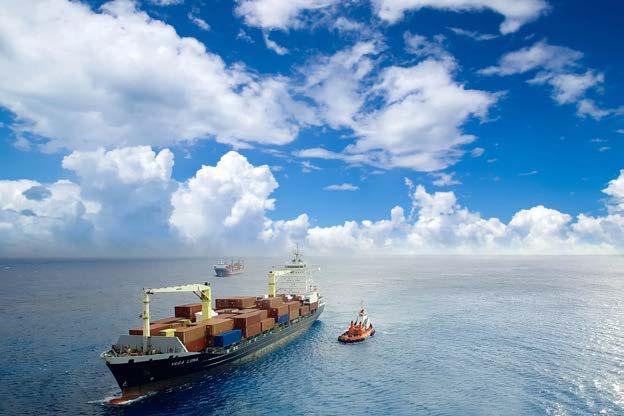

23 AÑOS EN EL MERCADO 8 Oficinas y operaciones en 8 países: Guatemala, El Salvador, Honduras, Nicaragua, Costa Rica, Panamá, Perú y Ecuador. EN ALIANZA CON info.pa@transtainer.net / +507-830-5850 CONTACTANOS AGENCIA DE CARGA TRASNPORTE TERRESTRE AGENCIAMIENTO DE ADUANAS ALMACÉN & DISTRIBUCIÓN PROYECTOS ESPECIALES SEGURO DE CARGA AGENCIAMIENTO PORTUARIO
KING OCEAN SERVICES

¡
Su línea naviera con 40 años brindando servicio marítimo carga contenerizada con salidas semanales desde Port Everglades, FL hacia Centro América y Panamá, Aruba, Bonaire, Curacao, Caribe Oriental, Colombia, Perú, Ecuador y Venezuela.



Consolidación LCL semanal desde Miami hacia Panamá, Costa Rica, Guatemala, Honduras, Nicaragua, San Andrés, Caribe Oriental, Colombia y Venezuela.
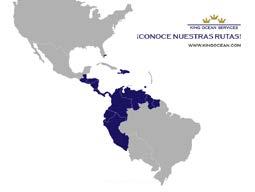
Nueva bodega con 158,000 Square Feet espacio, 64 puertas.
Una amplia flota de equipos FCL secos de 20´/40´/45'(96") y equipos refrigerados de 20´/40´RF , asi como equipos especiales Flat Racks , unidades, breakbulk.
VENTAS: Geraldine.alonzo@kingocean.com
Yineska.cortes@kingocean.com
Zahyra.vivas@kingocean.com
TELÉFONO:
PÁGINA WEB: www.kingocean.com 263-0100

Ofrecemos y brindamos una extensa red de oficinas e instalaciones dentro y a lo largo de de nuestros destinos. Brindamos un servicio rápido confiable y sobre todo personalizado. CONOCE
NUESTRASRUTAS!
Congreso Especializado
IMPACTO DE LA TECNOLOGÍA EN LAS OPERACIONES LOGÍSTICAS
KEYNOTE SPEAKER: AMAZON WEB SERVICE | LA CULTURA DE LA INNOVACIÓN LUIS




LA IMPORTANCIA DE LA DEBIDA DILIGENCIA EN LAS OPERACIONES COMERCIALES GIOMAR GONZÁLEZ | DIRECTORA DE BASC
CÓMO ACERTAR EN LA INTRODUCCIÓN DE TECNOLOGÍA EN LA CADENA DE SUMINISTRO PERE CASTELL | CHIEF OPERATIONS OFFICER - LOGISFASHION

CASOS DE ÉXITO DE DIGITALIZACIÓN, AUTOMATIZACIÓN Y ANALÍTICA AVANZADA EN OPERACIONES LOGÍSTICAS EDSON GUIMARÃES| MCKINSEY & COMPANY

NEARSHORING & LOGÍSTICA: DRIVERS DE CRECIMIENTO ARTURO FRÍAS | DIRECTOR GENERAL, GLOBAL LOGISTICS CONSULTING.
Incluye:
- Kit de bienvenida
- Acceso al área de exhibición
CARLO ARIAS | TERRITORY ACCOUNT MANAGER
panacamara.com/expologistica/
30 DE MARZO 2023 | Panama Convention Center Amador
CONFERENCIAS | NETWORKING | PANELES
¡Reserva tu participación!
OBSERVATORIO MUNDIAL DE LOGÍSTICA PREVENTIVA Y LOGÍSTICA JUSTA
RICARDO PARTAL SILVA – PRESIDENTE, ORGANIZACIÓN MUNDIAL DE CIUDADES Y PLATAFORMAS LOGÍSTICAS.
TENDENCIAS ACTUALES EN LA INFRAESTRUCTURA Y LA ECONOMÍA PORTUARIA Y MARÍTIMA
RICARDO SÁNCHEZ, DOCTOR EN ECONOMÍA | CARIBBEAN RESEACH INSTITUTE, CARIBBEAN SHIPPING ASSOCIATION.




EVOLUCIÓN DE LA INDUSTRIA DE LOGÍSTICA Y TRANSPORTE: EL ASCENSO DE LA INTELIGENCIA ARTIFICIAL DR. ROOZBEH SADEGHIAN | HARRISBURG UNIVERSITY

LA IMPORTANCIA ENTRE LA ATENCIÓN Y LA PRODUCTIVIDAD RAMIRO CASÓ | INCAE BUSINESS SCHOOL
ZONA LIBRE DE COLÓN
GIOVANNI FERRARI | GERENTE – ZONA LIBRE DE COLÓN
PANEL: LA URGENCIA DE IMPLEMENTAR LA TECNOLOGÍA PARA PROMOVER LA EFECTIVIDAD EN LOS SERVICIOS LOGÍSTICOS
- Material didáctico, - Certificado de participación y refrigerio

expologistica@panacamara.org




EditorDel
From the Editor
Al Creador damos las gracias por permitirnos volver a ver la luz como publicación luego de un período de ponderación, ensayo y error y resiliencia que, de manera compartida, la humanidad no había visto desde la primera mitad del siglo pasado. Aceptamos, pues, este privilegio como el reto de convertirnos en el principal anuario logístico del país en un futuro próximo, fortaleciendo nuestra plataforma y marca en el cambiante mundo digital.
Ciertamente damos las gracias por Panamá y por su industria logística, los marcos geográfico y económico en los cuales vivimos y actuamos, ya que bien sortearon, cual bautismo de fuego, las vicisitudes ocasionadas por la pandemia y su consecuente descalabro financiero para resurgir, mano a mano, como una de las economías de mayor crecimiento de la región.
Sabemos, no obstante, que no todo es color de rosas, especialmente en el sector microeconómico, en donde el empleo informal y el desempleo, la escasez de mano de obra calificada, la falta de mantenimiento de la red vial y la brecha digital que existe entre los sectores público y privado continúan siendo los principales escollos de la industria. También sabemos que donde hay crisis hay más de una oportunidad. ¡El país continuará creciendo y se hará más fuerte!
No podemos dejar de dar gracias en esta edición a todos nuestros anunciantes, que con paciencia supieron esperar nuestro retorno ¡Gracias por ser nuestro principal motor e inspiración! ¡Gracias! ¡Muchas gracias!
Gabriel E. Leonard DIRECTOR EJECUTIVO MANAGING DIRECTOR

We hereby thank The Creator for allowing us to see the light as a publication once more after one of the longest periods of ponderation, trial-and-error, and resilience humanity as a whole has ever seen since the first half of the 20th century. We, therefore, accept this privilege as the challenge to become the country’s main logistics yearbook in the not-so-distant future by strengthening our platform and name-brand in the everchanging digital world.
We give thanks for Panama and its logistics industry –the geographic and economic frameworks in which we live and interact, as they were able to weather (as experiencing a baptism of fire) the financial debacle caused by the pandemic to re-emerge, hand in hand, as one of the fastest-growing economies of the region.
We also know, nevertheless, that all is not sunshine and rainbows, especially in the microeconomic sector, where both unemployment and informal employment, the scarcity of qualified personnel, the lack of road maintenance, and the digital gap that exists between the public and private sectors continue being the main hurdles of the industry. We also know that there is more than one opportunity wherever there is a crisis. The country is only bound to continue growing and will become stronger!
Lastly (but not least,) we cannot forget to thank the advertisers of this issue for patiently awaiting our return. Thanks to all of you for being our principal motivation and inspiration! Thank you from the bottom of our hearts!
12 2023 - 2024 info@vallenardeditores.net +507 6326-3529


Contenido/Content
¿POR QUÉ ESCOGER PANAMÁ…?
16 32
WHY CHOOSE PANAMA…?


20 45
NUESTRA INFRAESTRUCTURA LOGÍSTICA
OUR LOGISTICS INFRASTUCTURE



VALLENARD EDITORES

+507-6326-3529/+507-6037-5471
E-mail: info@vallenardeditores.com
https://vallenardeditores.net
https://guialogisticapanama.net
Facebook & Instagram:
@Guialogisticapanama
ZONAS FRANCAS FREE TRADE ZONES
Director ejecutivo/Managing Director


Gabriel E. Leonard
Asesor económico/Economic Advisor
Rigoberto González Montenegro
Diseño y diagramación/Design & Layout
Eliseo Núñez Osorio
Editor fotográfico/Photo Editor
Gustavo Miller
La Guía Logística es una publicación elaborada por Vallenard Editores. Está prohibida la reproducción total o parcial de su contenido. No nos hacemos responsables por el contenido de los avisos publicitarios pautados por los anunciantes.
The Logistics Guide is edited by Vallenard Editores. The total or partial reproduction of its content is strictly prohibited. The company is not responsible for the content of the commercial advertisements herein published
Moviendo carga para impactar al mundo Moving cargo to impact the world Gaviria Investments Corp
ANÁLISIS DEL SECTOR LOGÍSTICO DE PANAMÁ AN ANALISYS OF PANAMA’S LOGISTICS SECTOR





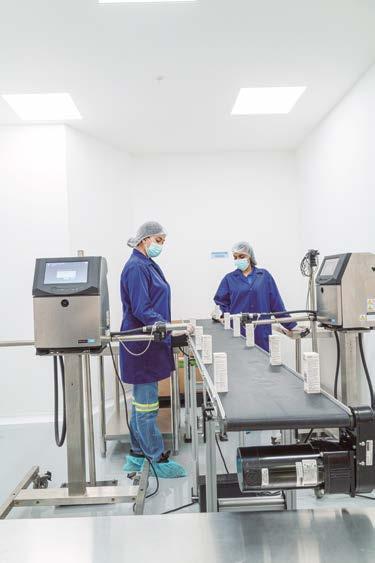

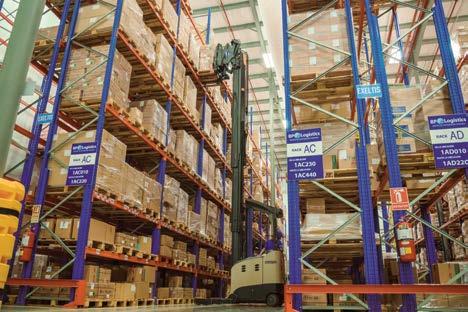
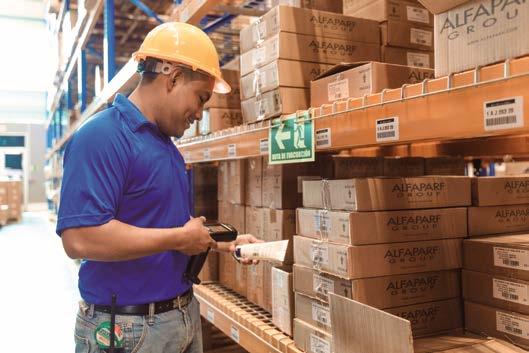
Panamerica Corporate Center, Edificio 9075, locales 2&3 Panamá Pacífico, Panamá Tel: (507) 360-7815 Cel: (507) 6977-8167 www.bplogis�cs.com.pa Inbound, Outbound y Trámites de Aduana Recepción e inspección Almacenaje Especializado: Cosmé�cos, Electrónicos (15°C a 25°C; 2°C a 8°C) Control de Inventario 24/7 Ac�vidades de Valor Agregado Picking, Preparación, Empacado y Despacho de la Orden Ofrecemos los siguientes
Panamá ¿Por qué escoger
COMO SU BASE REGIONAL DE NEGOCIOS?
Con una posición geográfica como pocas en el mundo, la logística y el comercio internacional suelen ser las respuestas más rápidas a esta pregunta; no obstante, la existencia de su famoso canal no es lo único que define al país en cuanto a los negocios internacionales. He aquí algunas de las razones que hacen único a este país centroamericano.
UNA NACIÓN DE PAZ
Sin paz no hay ambiente propicio para los negocios y Panamá es prueba contundente de ello. Gozando de una democracia estable desde 1990, el país ocupa actualmente la posición 61 del Índice de Paz Global (IPG) 2022 y es el segundo Estado más pacífico de Centroamérica y el Caribe, a la vez que lleva años figurando entre las economías de mayor crecimiento de la región. Panamá es el segundo país del Hemisferio
Although logistics and international trade are generally provided as short answers to this question given the country’s unbeatable geographic position, there is a lot more defining Panama in the world of international business beyond its famous Canal. The following are a few features that make this small, Central American country unique.

A NATION OF PEACE
It’s a fact that businesses cannot thrive in environments that are void of peace, and Panama is proof of the opposite. Enjoying a stable democracy since 1990, the country currently occupies position No. 61 on the Global Peace Index (2022) and is the second most peaceful nation in Central America and the Caribbean, just as it has been counted amongst the fastest-growing economies in the region in the last few decades. Panama is the second country in the Western
16 2023 - 2024 info@vallenardeditores.net +507 6326-3529
Why choose Panama as your regional business headquarters?
que ha abolido sus fuerzas armadas.
UNA MONEDA ESTABLE Y GLOBAL
Si bien la moneda oficial de Panamá es el balboa, creada en 1904, una de las curiosidades financieras del país es el artículo 262 de su Constitución Política, que reza: “No habrá en la República papel moneda de curso legal forzoso”.
A partir de un acuerdo monetario firmado entre Panamá y Estados Unidos el 20 de junio de 1904, el valor del balboa panameño en la República es el mismo del dólar estadounidense, cuyos billetes son los únicos que circulan en el país. El país carece, por ende, de un banco central propiamente dicho (papel parcialmente asumido por el Banco Nacional de Panamá), dando como resultado una inflación anual promedio de entre 1% y 3%
¡UNA PEQUEÑA ECONOMÍA CON MÁS DE 70 BANCOS!
A pesar de ser una economía de poco más de 4 millones de habitantes, el uso del dólar estadounidense, sus atractivas leyes financieras y las actividades relacionadas al Canal de Panamá han atraído, históricamente, a una cantidad considerable de bancos a la plaza financiera panameña. Según la Superintendencia de Bancos de Panamá, hasta diciembre de 2022 operaban en la nación 73 instituciones financieras, entre entidades de licencia general, internacional y oficinas de representación.
ATRACTIVA LEGISLACIÓN TRIBUTARIA
Uno de los principales atractivos para establecer su negocio en Panamá es su excelente legislación tributaria, que solo grava los ingresos generados dentro del territorio nacional. Se aplica un 25 % de impuesto sobre los ingresos netos gravables.
Hemisphere to abolish its armed forces.
A STABLE, GLOBAL CURRENCY
Although the country’s official currency is the balboa (created in 1904), one of Panama’s financial oddities is Article 262 of its Constitution, which reads, “There shall not be in the Republic paper money of legal tender.” Based on a monetary agreement signed between Panama and the United States on June 20, 1904, the Panamanian balboa is permanently at par with the US dollar, the bills of which are the only ones authorized to circulate as legal tender within the territory of the Republic. The country, therefore, has no central bank per se (a role partly assumed by Banco Nacional de Panamá) resulting in an inflation rate that averages between 1-3%
A SMALL ECONOMY WITH OVER 70 BANKS!
Despite being a small economy of little over 4 million inhabitants, Panama has historically attracted a considerable number of banks, thanks to the use of the US dollar, its attractive financial legislation, and the commercial activities related to the Panama Canal.

17 2023 - 2024 @Guialogisticapanama
SU CONECTIVIDAD
El país es, literalmente, uno de los más interconectados del mundo. Su famoso canal sirve a unas 144 rutas marítimas y aproximadamente 1,700 puertos en todo el mundo, mientras que cientos de miles de pasajeros al año transitan o hacen conexiones a todo el continente americano, Europa y Asia a través del Hub de las Américas, que opera en el Aeropuerto Internacional de Tocumen. Cabe destacar que 7 de los principales cables submarinos de fibra óptica pasan a través del istmo de Panamá.
SU GENTE
Desde tiempos inmemoriales, Panamá ha sido, gracias a su posición geográfica, un gran encuentro de culturas, hecho que se intensificó durante los últimos 150 años con la construcción, tanto del ferrocarril como del Canal de Panamá. Los panameños somos hijos de españoles y de otros europeos, indígenas, africanos, asiáticos, caribeños, estadounidenses, latinoamericanos, y en muchos casos, mantenemos vivas las culturas e idiomas de nuestros ancestros, con lo cual se nos facilita la comunicación a la hora de hacer negocios internacionales.

According to Panama’s Superintendency of Banks, 73 financial institutions, including general and international-licensed banks and representation offices, operated in the country as of December 2022.
ITS ATTRACTIVE TAX LEGISLATION
One of the main features that make opening your business in Panama an attractive idea is the country’s excellent tax legislation, which is only applicable to income generated within the national territory. A 25% tax is applicable on net taxable income.
ITS CONNECTIVITY
The country is one of the world’s most interconnected nations. Its famous Canal serves 144 maritime routes and approximately 1,700 ports around the world, just as hundreds of thousands of passengers per annum arrive, depart, or make connections throughout the Americas, Europe, and Asia via the Hub of the Americas, which operates at Tocumen International Airport. It is pivotal to underline that 7 of the world’s most important submarine fiberoptics cables pass through the Isthmus of Panama.
ITS PEOPLE
Since time immemorial, Panama has been regarded as a large cultural melting pot, a fact that has intensified during the last 150 years with the construction of both the Panama Railroad and the Panama Canal. Those of us who call ourselves Panamanian are often the children of Spaniards and other Europeans, of indigenous peoples and Africans; of Asians and Central Americans, and immigrants from the Caribbean, the United States, and South America. As such, we have been able, in many cases, to keep the cultures and languages of our ancestors alive, thus making it easy for us to communicate with our peers when engaging in international business.
18 2023 - 2024 info@vallenardeditores.net +507 6326-3529

INFRAESTRUCTURA:
especial vocación testimonio permanente
de nuestra
Infrastructure: A permanent Testimony of our Special Vocation
TRANSPORTE TERRESTRE: BASTIÓN LA CADENA LOGÍSTICA
Panamá cuenta con uno de los mejores sistemas de carreteras de América Central –una red de más de 15,000 kilómetros. El país es atravesado de oeste a este por la Carretera interamericana (con excepción del Tapón del Darién), que brinda acceso, tanto a la mayoría de centros urbanos de la República, como a Centro y Norteamérica. De igual manera, lo recorren, de norte a sur, la Carretera transístmica y la autopista Alberto Motta, que permite acceder a ambas costas en menos de una hora. Los corredores Norte y Sur fueron construidos entre los años 1990 y principios del presente siglo para aliviar el pesado tráfico de ciudad de Panamá y su

OVERLAND TRANSPORT: A PILLAR OF THE LOGISTICS CHAIN
Panama boasts one of the best road systems in Central America –a network of over 15,000 kilometers. The country is traversed from east to west (with the exception of the Darien Gap) by the InterAmerican Highway, which provides access to most of the country’s main towns and cities, in addition to Central and North America. Likewise, it is traversed from north to south by the Trans-Isthmian Highway and by the Alberto Motta Expressway, which allows motor vehicles to reach either coast in a little less than an hour.
The North and South expressways were built in the 1990s and early 2000s to
20 2023 - 2024 info@vallenardeditores.net +507 6326-3529
área metropolitana.
PANAMA CANAL RAILWAY COMPANY
Panama Canal Railway Company, sucesor del antiguo Ferrocarril de Panamá (el primer tren transcontinental del mundo), es el único operador ferroviario de carga del país. Este ferrocarril conecta la terminal portuaria de Balboa, sobre el Pacífico, permitiendo el embarque y desembarque expedito de contenedores con destino a las terminales marítimas de Cristóbal y MIT, sobre el Caribe. La terminal de Cristóbal permite el embarque de pasajeros y de contenedores con un servicio dentro del puerto. La terminal MIT se encuentra a un costado del parque logístico MIT, a 500 metros del puerto de Manzanillo y a 2,000 metros del puerto de CCT.
El modelo de operaciones de PCRC consiste principalmente en proveer un sistema de trasbordo eficiente y de alto volumen entre los puertos del Caribe y el Pacífico.
Los trenes operan continuamente entre las terminales intermodales de ambas costas con capacidad de 10 trenes en cada dirección (norte y sur) cada 24 horas.
Las operaciones de carga y descarga de un tren en las terminales toma aproximadamente 2 horas. El horario para los mismos varía dependiendo de las operaciones en los puertos y de la demanda por parte de las
alleviate the heavy traffic of the Panama City metro area.
PANAMA CANAL RAILWAY COMPANY
The Panama Canal Railway Company, the successor of the old Panama Railroad (the world’s first trans-continental train system,) is the only cargo railway operator in the country. The railroad is connected at the Pacific coast to the port of Balboa, allowing the expedited loading and discharging of containers bound to the Caribbean-coast maritime terminals of Cristobal and MIT. The port of Cristobal allows the embarking of passengers and the loading of containers with an in-dock service. The MIT terminal is next to its logistics park, 500 meters from the port of Manzanillo, and 2,000 meters from the port of CCT.
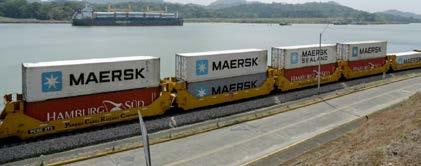
The PCRC operational model aims to provide an efficient, high-volume transshipment system between Panama’s ports on the Atlantic and Pacific.
Trains operate continuously between the intermodal terminals on boast coasts with a capacity of 10 trains in each direction (north and south) every 24 hours.
The loading and unloading of a train at the terminals take about 2 hours. The schedules vary depending on the port operations and demand from shippers who use Panama as a link to other parts of the
21 2023 - 2024 @Guialogisticapanama
navieras que utilizan a Panamá como punto de conexión hacia otras partes del mundo.
En promedio, 2,000 contenedores son transportados diariamente en ambas direcciones, alcanzando un movimiento anual de aproximadamente 650,000 unidades. El viaje recorre alrededor de 76 kilómetros y un tiempo de 1 hora y 15 minutos entre los complejos portuarios situados en ambas costas. Un juego de 6 vagones de pasajeros es utilizado durante los días de semana en un horario fijo, principalmente por turistas y ejecutivos que viajan desde ciudad de Panamá hacia la Zona Libre de Colón. La capacidad máxima de manejo del servicio se ha estimado en 2,000,000 de contenedores por año.
MOVILIDAD URBANA: CLAVE PARA LAS CIUDADES MODERNAS
El programa de modernización del transporte público del área metropolitana de Panamá está compuesto por el Metro de Panamá y el sistema Metro Bus. Ambos sistemas son compatibles uno con el otro para optimizar el tiempo de recorrido del usuario a lo largo y ancho de la capital panameña.
Los trabajos de construcción de la Línea 1 iniciaron en 2011, empezando operaciones el 6 de abril de 2014. El Metro de Panamá es el primero en toda América Central. Su Línea 1 está compuesta por 14 estaciones y
world.
On average, 2,000 containers are transferred per day in both directions for a yearly throughput of about 650,000 units. The trip is about 76 kilometers and an hour and 15 minutes between terminals on either coast. A set of 6-passenger cars are used during weekdays under a fixed schedule, mainly for tourists and executives traveling from Panama City to the Colón Free Zone. The maximum handling capacity of the service has been estimated at 2,000,000 containers per year.
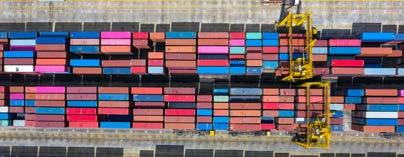
URBAN MOBILITY: KEY TO MODERN CITIES
The Panama Metro and Metro Bus services are part of the modernization program of Panama City’s public transportation. Both systems are compatible, seeking to optimize passenger travel time throughout the Panama City metro area.
Construction works for Line 1 began in 2011 and started operations on April 6, 2014. It is the first project of its kind in Central America. Line 1 comprises 14 stations and 2 terminals, providing transport to anywhere from 240,000 and 280,000 passengers per day.
Line 2, on the other hand, connects the San Miguelito Terminal to the growing suburban communities to the east of the capital. Starting operations in early 2019,
22 2023 - 2024 info@vallenardeditores.net +507 6326-3529

2 terminales, propiciando una movilidad de entre 240,000 y 280,000 pasajeros al día.
La Línea 2, por su parte, conecta la terminal de San Miguelito con las crecientes comunidades de la periferia este de la capital. En funcionamiento desde principios de 2019, la misma cuenta con 17 estaciones, siendo la más reciente la del Aeropuerto Internacional de Tocumen, inaugurada en marzo de 2023, y que eleva la plusvalía de este medio de comunicación al permitir que miles de visitantes internacionales tengan acceso a la capital de una manera rápida, económica y segura.
Cabe destacar que ya se encuentra en construcción de la Línea 3, que conectará la terminal de Albrook con Ciudad del Futuro, beneficiando a los más de 500,000 residentes de la provincia de Panamá Oeste, muchos de los cuales laboran en ciudad de Panamá.
La primera fase de la Línea 3, de 24.5 kilómetros de extensión (incluyendo un túnel submarino que unirá ambas riberas del Canal de Panamá), brindará un rápido acceso al Área Económica Especial de Panamá Pacífico, y las poblaciones de Arraiján y Nuevo Chorrillo, entre otras.
El trazado de esta línea, que recorre en parte terreno montañoso, se ha optimizado, reduciendo pendientes y ampliando radios de giro, para obtener el mejor desempeño del monorriel.
the line features 17 stations, the most recent one being Tocumen International Airport, which opened in March 2023, and which adds value to this means of transportation by allowing thousands of international visitors to access Panama City in an expedited, cost-friendly, and safe manner.
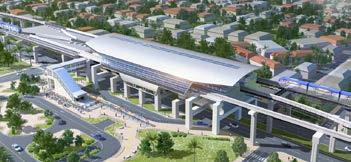
It is also important to mention that Line 3 of the Metro system is already under construction, soon to connect the Albrook terminal to Ciudad del Futuro for the benefit of the over half-a-million residents of the Panama Oeste province, many of whom work in Panama City.
In its first phase (24.5 kilometers), the Line 3 project, which includes the construction of a submarine tunnel under the Panama Canal, will provide rapid access to the Panama Pacifico Special Economic Area and the towns of Arraiján and Nuevo Chorrillo, among others.
The line’s layout, which covers mountainous terrain, has been optimized by the lowering of slopes and the widening of curves to improve the monorail’s performance.
24 2023 - 2024 info@vallenardeditores.net +507 6326-3529
Ya se encuentra en construcción la Línea 3, que conectará la terminal de Albrook con ciudad del futuro.
El Metro de Panamá transporta aproximadamente 280,000 pasajeros al día. /Panama City’s Metro system transports approximately 280,000 passengers each day

El complejo portuario panameño presenta su mayor fortaleza en ambas entradas del Canal de Panamá. El mismo, que se especializa en carga contenerizada, incluye tres terminales en el Caribe y dos en el Pacífico.

26 2023 - 2024 info@vallenardeditores.net +507 6326-3529
Panama´s seaport complex shows its greatest strength at both Panama Canal entrances. It specializes in containerized cargo that includes three terminals on the Caribbean side, and two on the Pacific coast.

27 2023 - 2024 @Guialogisticapanama
The Panama Canal: Our Main Logistics Asset

EL CANAL DE PANAMÁ:
activo logístico nuestro principal
No cabe duda de que el gran logro de Panamá en materia logística en lo que va del siglo ha sido la inauguración de la ampliación del Canal de Panamá el 26 de junio de 2016. El megaproyecto de ampliación se llevó a cabo entre 2007 y 2016 a un costo estimado de US$5,400 millones.
Considerado una de las “Siete Maravillas del Mundo Moderno” por la Sociedad Americana de Ingenieros Civiles, el canal, por el que pasa aproximadamente el 6% del comercio mundial, ha enfrentado con éxito los retos a los que se ha visto sometido el mundo en los últimos 3 años, como la pandemia por Coronavirus, la guerra en Ucrania y las grandes disrupciones en la cadena de suministro global ocasionadas por ambas situaciones, gracias a la visión que tuvo el pueblo panameño a la hora de aprobar la ampliación de la obra, mediante referéndum, en 2006.
There is no doubt that Panama’s greatest achievement in the realm of logistics during the present century has been, so far, the opening of the expanded Panama Canal on June 26, 2016. The expansion mega-project was carried out between 2007 and 2016 at an estimated cost of US$5.430 billion.
Considered one of the “Seven Wonders of the Modern World” by the American Association of Civil Engineers, the Canal, through which 6% of global trade passes, has successfully weathered the challenges the world has faced in the last 3 years, such as the Coronavirus pandemic, the war in Ukraine, and the subsequent supply-chain disruptions caused by both situations, thanks to the vision of the people of Panama to approve the expansion of the waterway through a referendum in 2006.
The opening of the expanded Canal has had a multiplying effect, not only on
28 2023 - 2024 info@vallenardeditores.net +507 6326-3529
The opening of the expanded Canal has had a multiplying effect, not only on the maritime industry of Panama but on the world of logistics and international commerce as well.
La inauguración del canal ampliado ha tenido un efecto multiplicador, no solo en la industria marítima nacional, sino también en todo el mundo de la logística y el comercio internacional.
Ejemplo de esto se observa en la costa oriental de Estados Unidos, en donde seis puertos han invertido millones de dólares a fin de acomodar a los buques de mayor calado procedentes de Asia a través del canal. Dichos puertos son los de Savannah, Miami, Jacksonville, Nueva York/Nueva Jersey, Nueva Orleans y Charleston. Cabe destacar que dichas instalaciones marítimas se encuentran en una de las franjas económicas y demográficas más importantes del mundo.
Las esclusas del canal ampliado miden 427 metros (1,400 pies) de largo por 55 metros (180 pies) de ancho y 18.3 metros (60 pies de profundidad), aptas para recibir buques de hasta 49 metros (160 pies) de ancho, 366 metros (1,200 pies) de largo, y 15 metros (50 pies) de profundidad o con un volumen de carga de hasta 170,000 toneladas de peso muerto y 12,000 TEUs.
CONECTIVIDAD AÉREA DE CLASE MUNDIAL
Panamá posee una de las más avanzadas infraestructuras aeroportuarias de América Latina. Dada su localización, su principal aeropuerto, el Internacional de Tocumen, se ha convertido en un importante hub de conexiones para las Américas, Europa y Asia.
El Aeropuerto Internacional de Tocumen es una de las terminales áreas más importantes de la región por número de destinos y tráfico movilizado. Antes de la pandemia
the maritime industry of Panama but on the world of logistics and international commerce as well.

An example of this is seen on the east coast of the United States, where six seaports have invested billions of dollars in order to accommodate larger vessels arriving from Asia via the Canal. Said ports are Savannah, Miami, Jacksonville, New York/New Jersey, New Orleans, and Charleston. It is pivotal to underline that these maritime facilities are located in one of the world’s most important stretches of land in financial and demographic terms.
The locks of the expanded Panama Canal measure 427 meters (1,400 feet) long by 55 m (180 feet) wide and 18.3 m (60 feet) in depth, designed to allow the transit of ships of up to 49 meters (160 feet) wide, 366 meters (1,200 feet) long, and 15 meters (50 feet) deep, or with a cargo volume capacity of up to 170,000 deadweight tons and 12,000 TEUs.
WORLD-CLASS AERIAL CONNECTIVITY
Panama has one of the most advanced airport infrastructures in Latin America. Given its geographic position, Tocumen International, the country’s largest air facility, has become a very important hub for connecting the Americas, Europe, and Asia.
29 2023 - 2024 @Guialogisticapanama
global operaban 23 aerolíneas comerciales, conectando a 85 destinos hacia 37 países al rededor del mundo.
En el 2006 se llevó a cabo un importante programa de expansión y renovación a largo plazo, con el objetivo de modernizar y mejorar sus servicios. La segunda fase de expansión del aeropuerto comprendió la construcción del “Muelle Norte” que ha permitido al aeropuerto aumentar su capacidad en un 50%, permitiéndole manejar hasta 15 millones de pasajeros por año.

En el año 2022 se inauguró la Terminal 2, un edificio con diseño vanguardista que aumenta la capacidad del complejo aeronáutico a 54 puertas de embarque y 12 posiciones remotas (operativas actualmente). Esta expansión permitirá aumentar la capacidad de movilizar hasta 21 millones de pasajeros cómodamente.
Su complemento más reciente ha sido la apertura, en marzo de 2023, de una estación de El Metro de Panamá en medio de sus instalaciones, permitiendo el transporte rápido, económico y seguro de miles de visitantes internacionales desde y hacia el centro de la capital panameña.
Tocumen International Airport is definitely one of the most advanced in the region in terms of the number of destinations and traffic volume. Before the Covid pandemic, the airport served 23 commercial airlines connecting 85 destinations in 37 countries around the globe.
In 2006, a long-term expansion and renovation program was launched to improve and modernize the airport’s services. The second phase of the airport’s expansion encompassed the construction of the “Northern Gates”, allowing the airport to increase its capacity by 50% and handle up to 15 million passengers per annum.
In 2022, Terminal 2, a structure featuring a futuristic design, was opened to increase the airport’s number of gates to 54 plus 12 remote positions (currently operational). The new facility now allows the airport to comfortably handle up to 21 million passengers per year.
The Airport’s most recent addition has been the opening of a terminal of Panama City’s Metro system within its premises, allowing thousands of international visitors easy, costfriendly, and safe transport to and from the center of the Panamanian capital.
30 2023 - 2024 info@vallenardeditores.net +507 6326-3529
El canal, por el que pasa aproximadamente el 6% del comercio mundial, ha enfrentado con éxito los retos a los que se ha visto sometido el mundo en los últimos 3 años./
The Canal, through which 6% of global trade passes, has successfully weathered the challenges the world has faced in the last 3 years.

Por: Lic. Rigoberto González Montenegro. ECONOMISTA
Logístico de Panamá Análisis del Sector
ENERO-SEPTIEMBRE DE 2022
An Analysis of Panama’s Logistics Sector Between January and September of 2022

La logística juega un papel clave para la economía, y aporta elementos fundamentales para el crecimiento y desarrollo del país. La economía panameña es considerada como una de servicios ya que estos aportan entre el 70 y el 80% del PIB. Y, dentro de los servicios, destaca el sector logístico que es considerado como uno de los principales motores de nuestra economía.
I. PRODUCTO INTERNO BRUTO NACIONAL ANUAL (PIB) 2021
El buen desenvolvimiento del sector logístico ha permitido la recuperación del crecimiento económico del país que alcanzó 15.3 % (USD. 40,736.4 millones) en el 2021 luego de la caída del -17.9% en el 2020 por la pandemia (USD. 35,319.8 millones).
Durante los tres años anteriores a la pandemia, del 2016 al 2019, la economía panameña venía creciendo a penas un 4.3%. Con respecto al 2019 (USD 43,044 millones) el monto del PIB nacional del 2021 es menor en USD 2,307.6 millones. (-5.4%).
II. PRODUCTO INTERNO BRUTO ACUMULADO 2022. ENERO A SEPTIEMBRE
De enero a septiembre de 2022, la
The logistics sector plays a key role in the economy and yields fundamental elements for the country’s growth and development. The greater part of Panama’s economy corresponds to services, with the logistics sector being one of the main engines of said sector.
I. THE ANNUAL GROSS DOMESTIC PRODUCT (GDP) IN 2021
The good performance of the logistics sector has contributed to the economic recuperation of Panama, the growth of which reached the 15.3% mark in 2021 (USD 40.7 billion) after the -17.9 downfall the country had experienced in 2020 as a byproduct of the Covid pandemic (USD. 35.319.8 billion)
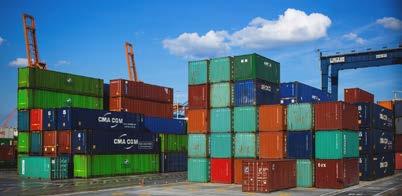
Between 2016 and 2019, the three years immediately prior to the sanitary emergency, the country’s economy had been experiencing a downward trend with a mere average growth of 4.3%. Compared to the nation’s GDP growth in 2019 (USD 43.0 billion) the figures reported in 2021 were USD 2.3 billion short (-5.4%).
II. CUMULATIVE GROSS DOMESTIC PRODUCT JANUARY-SEPTEMBER 2022
Between January and September of
33 2023 - 2024 @Guialogisticapanama
economía presentó un crecimiento acumulado de 11.0% comparado con igual período del año anterior. Correspondió a un monto de USD 32,340.6 millones, que representó un aporte en los nueve meses de USD 3,194.4 millones más que el mismo periodo de 2021 (USD 29,146 millones). Con respecto al 2019 (USD 31,846.6 millones) el monto del PIB nacional supera la cifra de ese año en 494 millones.
El buen desenvolvimiento del sector logístico ha permitido la recuperación del crecimiento económico del país que alcanzó 15.3 % (USD. 40,736.4 millones) en el 2021 luego de la caída del -17.9% en el 2020 por la pandemia (USD. 35,319.8 millones).

III. PIB DEL SECTOR LOGÍSTICO DE PANAMÁ 2021
La plataforma logística de Panamá es uno de los sectores claves para el dinamismo de la economía nacional, a través de su aporte al Producto Interno Bruto (PIB). Los sectores de transporte, almacenamiento y comunicaciones aportaron el 11.1% ($5,961.3 millones) a la producción real de
2022, the economy of Panama registered a cumulative growth of 11.0% compared with the same period in 2021. Said growth corresponds to USD 32.3 billion, or US3.2 billion more than the same period in 2021 (USD 29.1 million). Compared with the year 2019 (USD 31.9 million), the national cumulative GDP registered in 2021 was greater by 494 million dollars.
The good performance of the logistics sector has contributed to the economic recuperation of Panama, the growth of which reached the 15.3% mark in 2021 (USD 40.7 billion) after the -17.9 downfall the country had experienced in 2020 as a byproduct of the Covid pandemic (USD. 35.319.8 billion)
III. THE ECONOMIC OUTPUT OF PANAMA’S LOGISTICS SECTOR IN 2021
Panama’s logistics platform is regarded as one of the key sectors behind the dynamism of the country’s general economy as seen in its contribution to the Gross Domestic Product (GD). The Transport, Storage, and Communications sector, for example, represented 11.1% (nearly USD 6 billion) of
34 2023 - 2024 info@vallenardeditores.net +507 6326-3529
2021. Este aporte es todavía menor ($78 millones) si lo comparamos con el 2019 cuando alcanzó el monto de $6,039 millones.
IV. APORTES DEL SECTOR LOGÍSTICO 2021
En el último quinquenio, de 2017 a 2021, sector del transporte, almacenamiento y las comunicaciones ha aportado, en promedio, el 15% del producto interno bruto de Panamá a precios constantes, con una tasa de crecimiento promedio de 5% anual en el mismo periodo y para 2021, fue la segunda actividad de mayor aporte directo al PIB (14.6%).
V. APORTE DE LAS DIFERENTES ACTIVIDADES ECONÓMICAS AL PIB DEL SECTOR LOGÍSTICO
En 2019, el 47% de la actividad lo conformaba el transporte marítimo, relacionado a los servicios secundarios de transporte que presta la Autoridad del Canal de Panamá y otras actividades secundarias de transporte acuático (puertos). No queda la menor duda, por ende, que la inversión en infraestructura que se realizó con la
real production in 2021. This contribution, however, is USD 78 million less than that reported in 2019, the year in which the said sector contributed USD 6.03 billion to the country’s real production.
IV. CONTRIBUTIONS OF THE LOGISTICS SECTOR TO PANAMA’S ECONOMY IN 2021

During the last 5-year period (2017-2021), Transport, Storage, and Communications sector have, at constant prices, represented an average share of 15% of Panama’s Gross Domestic Product with an average growth rate of 5% per annum during the said period. By 2021, it was regarded as the second direct contributing sector to the GDP (14.6%).
V. THE CONTRIBUTION OF VARIOUS ECONOMIC ACTIVITIES TO THE OVERALL LOGISTICS OUTPUT OF PANAMA
In 2019, the maritime transport sector represented 47% of the general logistics output, more specifically the secondary transport services provided by the Panama Canal and other secondary maritime transport services (seaports.) There is no doubt, therefore, that the investment made
35 2023 - 2024 @Guialogisticapanama
ampliación del Canal de Panamá y en puertos ha tenido un efecto positivo contundente en la actividad económica, aunado a los efectos beneficiosos que percibe del aumento del comercio internacional dada la relación directa que existe.
Por otro lado, el movimiento de carga por vía terrestre representó el 18% del total del PIB del sector transporte en su conjunto, donde el transporte de carga genera aportes significativos. Por otro lado, el transporte aéreo contribuyó en 9% al valor agregado de la actividad, favoreciéndose por el Hub aéreo que opera en el Aeropuerto Internacional de Tocumen y que permite conexiones entre mercados y pasajeros de América, Europa y Asia y que se espera crezca su conectividad con la nueva ruta Panamá – China.

VI. MERCADO LABORAL
La actividad de transporte, almacenamiento y correo ha ocupado en promedio al 7.2% de la población de 15 y más años de edad en el país durante los últimos 3 años, según datos de la Encuesta de propósitos múltiples del Instituto nacional de estadística y censo (INEC).
to expand the Panama Canal and the port system in recent years has had a resounding, positive effect on this economic activity, along with the beneficial effects yielded by the increase in international trade.
The overland movement of cargo, on the other hand, represented 18% of the transport sector as a whole –a segment that, in turn, is an important source of revenue for the logistics industry in general terms. Strengthened by the “Hub of the Americas” that operates at Tocumen International Airport –the country’s largest—the air transport sector represents 9% of the logistics sector added value. Panama’s aerial transport system offers connections to markets throughout the Americas, Europe, and Asia, and is expected to grow with the new Panama-China route.
VI. THE LABOR MARKET
On average, the Transport, Storage, and Courier sector has employed 7.2% of the population ages 15 years or older during the last three years, according to data provided by the National Institute of Statistics and Census (INEC).
As of April 2022, said percentage
36 2023 - 2024 info@vallenardeditores.net +507 6326-3529
A abril de 2022, la ocupación en esta actividad sumó 145,853 personas, 8% más que en octubre de 2021.
VII. SECTOR LOGÍSTICO AL TERCER TRIMESTRE 2022

La variación del PIB acumulado de enero a septiembre 2022 para el sector logístico en su conjunto creció 13.6% ($4,871.48 millones). Su participación en el PIB nacional es del 14.6%.
La plataforma logística a través de sus indicadores muestra el dinamismo del sector. Dicho rubro está compuesto por el Canal de Panamá, los puertos en ambos océanos conectados por ferrocarril, El Aeropuerto Internacional de Tocumen, la red de aeropuertos a nivel nacional, y zonas económicas especiales que ofrecen incentivos a las operaciones logísticas, además de una serie de servicios logísticos nacionales e internacionales.
VIII. CANAL DE PANAMÁ
Al observar los datos concretos, podemos notar que el dinamismo de las actividades logísticas relacionadas al Canal de Panamá,
represented 145,853 people, 8% more than in October 2021.
VII. PERFORMANCE OF THE LOGISTICS SECTOR AS OF THE THIRD QUARTER OF 2022
The variation of the cumulative output of the logistics sector from January through September of 2022 has increased by 13.6% ($4.8 billion). The industry represents 14.6% of the country’s total GDP. The indicators of Panama’s logistics sector point towards a rather dynamic industry, which comprises the Panama Canal, a seaport system with facilities on both coasts linked by railroad; special economic zones offering investment incentives, and a broad range of national and international logistics services.
VIII. THE PANAMA CANAL
By analyzing hard data, one can easily see the dynamism of the activities related to the Panama Canal, which as of September of 2022 registered a total of 10,636 transits of large and small-draft trade vessels (a 7.2% increase,) which transported 217 million long tons and generated a total of 2.2 billion dollars
37 2023 - 2024 @Guialogisticapanama
que hasta septiembre de 2022 registró un total de 10,636 tránsitos de naves de alto y pequeño calado comercial (7.2% de crecimiento), los cuales transportaron 217 millones de toneladas largas y generaron peajes totales por el orden de los USD 2,245 millones de dólares. Esto representa un incremento de ingresos del 2.1% y un 0.1% de crecimiento en toneladas netas.
La variación del PIB acumulado de enero a septiembre 2022 para el sector logístico en su conjunto creció 13.6% ($4,871.48 millones). Su participación en el PIB nacional es del 14.6%.
En el 2021, las operaciones del Canal de Panamá tuvieron una variación positiva, efecto del aumento de los ingresos por peajes en 10.0% (a precios corrientes) y de los servicios prestados a naves en tránsito y segmentos de mercado no tradicionales del canal ampliado.

IX. SISTEMA PORTUARIO NACIONAL
Para el mes de septiembre de 2022, el sistema portuario nacional registró un decrecimiento anual de -1.8%, ocasionado por la caída en el movimiento de carga a
in tolls. This represents a 2.1% increase in tolls and a 0.1% increment in net tons.
The variation of the cumulative output of the logistics sector from January through September of 2022 has increased by 13.6% ($4.8 billion). The industry represents 14.6% of the country’s total GDP.
In 2021, the operations of the Panama Canal experienced a positive trend thanks to a 10% increase in toll revenue (at current rates), as well as a surge in services rendered to transiting vessels and nontraditional market segments provided by the expanded Canal.
IX. THE NATIONAL PORT SYSTEM
As of September 2022, the national port system had registered a -1.8% annual decrease as a result of a drop in bulkcargo movement, and a -1.6% downturn in the movement of container cargo. It had, nevertheless, experienced a 40% increase in general cargo.
In 2021, the services of the national port system displayed an 8.3% increase due to a surge in the movement of TEU containers, and of both bulk and general cargo (2.2%
38 2023 - 2024 info@vallenardeditores.net +507 6326-3529
granel de -3% y de la carga contenerizada (-1.6%), pero con un aumento en la carga general de 40%.
En el 2021, los servicios del sistema portuario nacional aumentaron 8.3%, debido al incremento en el movimiento de contenedores TEU en un 11.5%, y de la carga a granel y general en un 2.2% y 73.0%, respectivamente.
Cabe destacar que entre el 80% y 90% del comercio internacional se realiza a través del transporte marítimo, por comodidad, versatilidad y costos.
X. ZONA LIBRE DE COLÓN
De enero a septiembre, la Zona Libre de Colón que registró un incremento de 45.8% (USD 19,160 millones), impulsado por un aumento en las importaciones y las reexportaciones en 71.1% y 22.3%, respectivamente.

En concreto, la ZLC representa alrededor del 70 % del valor del comercio total del país en mercancías.
La venta de productos electrónicos, farmacéuticos, químicos, de perfumería y cosméticos, ropa en general, metales
and 73.0%, respectively).
It is important to mention that between 80% and 90% of international trade is carried out by maritime transport due to convenience, versatility, and cost.
X. THE COLÓN FREE ZONE
Between January and September of last year, the Colón Free Zone registered a 45.8% increase (USD 19.1 billion) prompted by a surge in imports and re-exports (71.1% and 22.3%, respectively).
In concrete terms, the CFZ represents approximately 70% of the total value of goods traded within our national borders.
The sale of electronic, pharmaceutical, and chemical products, in addition to perfumes, cosmetics, general apparel, common metals, and spirits remains the main force behind the growth of Panama’s largest free trade area.
XI. AERIAL TRANSPORT
Between January and September of 2022, Tocumen International Airport experienced a 65.2% increase in the movement of passengers (3.8 million) compared with the same period in 2021 (2.3 million), a fact that
39 2023 - 2024 @Guialogisticapanama
comunes y bebidas alcohólicas se mantienen entre los principales impulsores del crecimiento de la zona franca.
XI. TRANSPORTE AÉREO
De enero a septiembre de 2022, se registró el crecimiento en el tránsito de viajeros por el Aeropuerto Internacional de Tocumen de 65.2% (3.8 millones de pasajeros) con respecto al mismo período del 2021 (2.3 millones), hecho que presenta una correlación con la paulatina recuperación del sector turístico nacional y regional luego de la pandemia.

XII. TRANSPORTE TERRESTRE
El transporte por vía terrestre ha representado, en promedio, el 18.0% del Producto Interno Bruto (nominal) de la actividad de Transporte, almacenamiento y comunicaciones, para el periodo 20172020, manteniéndose para el 2020 (16.75%) por debajo del 2019 (18.7%)
De enero a septiembre, la Zona Libre de Colón que registró un incremento de 45.8% (USD 19,160 millones), impulsado
correlates with the gradual recuperation of the national and international tourism industries after the pandemic.
XII. OVERLAND TRANSPORT
Overland transport has represented, on average, 18% of the nominal, total output of the Transport, Storage, and Communications sector for the period between 2017 and 2020, and in 2020 it remained at 16.75% below 2019 figures (18.7%).
Between January and September of last year, the Colón Free Zone registered a 45.8% increase (USD 19.1 billion) prompted by a surge in imports and reexports (71.1% and 22.3%, respectively).
OVERLAND CARGO TRANSPORT
Panama’s overland cargo transport industry encompasses three sectors: long-range transport, followed by urban transport, and lastly, the overland cargo transport between the logistics facilities of the cities of Colón and Panama.
40 2023 - 2024 info@vallenardeditores.net +507 6326-3529
por un aumento en las importaciones y las reexportaciones en 71.1% y 22.3%, respectivamente.

TRANSPORTE TERRESTRE DE CARGA
El transporte de carga comprende tres sectores. El primero, el transporte por carretera de largo recorrido, luego el transporte de carga urbana y el transporte por carretera en las principales áreas de logística entre las ciudades de Colón y Panamá.
XIII. POSICIÓN COMPARATIVA DE PANAMÁ RESPECTO AL INDICADOR ÍNDICE DE COMPETITIVIDAD GLOBAL (GCI)
Panamá ha obtenido 61,64 puntos en el Índice de Competitividad 2019, publicado por el Foro Económico Mundial, que mide cómo utiliza un país sus recursos y capacidad para proveer a sus habitantes de un alto nivel de prosperidad. En esta sentido, el país ha mejorado su puntuación respecto al informe del año anterior, en el que obtuvo 61,03 puntos.
Panamá se ubica en el puesto 66 del
XIII. THE COMPARATIVE POSITION OF PANAMA VIS-A-VIS THE GLOBAL COMPETITIVENESS INDEX (GCI)
In 2019, Panama obtained 61.64 points in that year’s Competitiveness Index, published by the World Economic Forum, which measures how countries use their resources and capacity to provide their inhabitants with high levels of prosperity. In this regard, the country has improved its score vis-à-vis the previous year’s report, in which it obtained 61.03 points.
The country occupies the 66th position in the ranking of 141 countries. Compared to 2018, however, there was a two-position demotion (The country occupied position No. 64 said year).
XIV. LOGISTICS PERFORMANCE INDEX
At the regional level, Panama (38) and Chile (34) are part of the world’s top 40. Although the country decreased its score by 1.85%, it was able to climb two positions. The indicators in which Panama performed the best were Tracking Activities and Logistics Service Competence. Its weakness, on the other hand, was reflected in International
41 2023 - 2024 @Guialogisticapanama
ranking de competitividad mundial, de los 141 países analizados. Con respecto al 2018, observamos un descenso de dos escaños, ya que en aquel entonces figuraba en el puesto 64.
Panamá (52.11) cuenta con el mejor desempeño del LSCI en la región de América Latina y el Caribe (ALC), seguida de Colombia (31), México (32), Perú (37) y Ecuador (38).
XIV. ÍNDICE DE DESEMPEÑO LOGÍSTICO
A nivel regional, Panamá (38) y Chile (34) se encuentran en el top 40 mundial. Si bien nuestro país disminuyó su puntuación en 1.85%, podemos apreciar que escaló dos posiciones. Los indicadores de mejor desempeño fueron Seguimiento y Rastreo, así como Competencia de Servicios Logísticos. Su debilidad, por otro lado, se ve reflejada en Envíos Internacionales y Puntualidad.
La encuesta a nivel mundial se basa en las percepciones de profesionales de logística (agentes de carga y express carriers). Permite realizar comparaciones
Imports and Punctuality.
This worldwide survey is based on the perceptions of logistics professionals (cargo agents and express carriers) and fosters comparisons between countries to broadly identify potential areas for improvement. It’s important to underscore that, rather than being a tool for diagnosis, the index is a general metric of the efficiency of supply chains. Its six components are graded on a scale from 1 to 5: 1. Customs 2. Infrastructure 3. Service quality 5. Time 5. International Shipping, and 6. Tracking. As of 2018, the number of surveyed countries was 160.
Panamá (52.11) exhibits the LSCI’s best performance in the Latin America & Caribbean region, followed by Colombia (31), Mexico (32), Peru (37), and Ecuador (38).

XV. THE LINER SHIPPING CONNECTIVITY INDEX
The Liner Shipping Connectivity Index or LSCI is a calculation created by the United Nations Conference on Trade and Development (UNCTAD) with the purpose of evaluating the capacity of any surveyed
42 2023 - 2024 info@vallenardeditores.net +507 6326-3529
Índice de Conectividad Marítima, Trimestral Puntaje General de Panamá
entre países, e identifica de manera general las áreas de oportunidades de mejora. El LPI crea conciencia en los países para impulsar políticas de conectividad y logística. Es importante destacar que no es considerada una herramienta de diagnóstico; más bien, es una métrica general sobre la eficiencia de las cadenas de suministro. Se califican 6 componentes en una escala del 1 al 5: 1. Aduanas 2. Infraestructura 3. Calidad de servicios 4. Tiempo 5. Embarques internacionales 6. Trazabilidad. Cantidad de países encuestados (2018): 160.
XV. ÍNDICE DE CONECTIVIDAD MARÍTIMA O LSCI
El Índice de Conectividad Marítima o LSCI es un cálculo realizado por la Conferencia de las Naciones Unidas sobre Comercio y Desarrollo (UNCTAD, por sus siglas en inglés) con el propósito de evaluar la capacidad de los puertos de un país para el transporte de contenedores de 20 pies por vía marítima a otros destinos.
La metodología actual considera 6 componentes principales para su
country’s seaports to transport 20-foot containers to other destinations.
The survey’s methodology considers six main areas: the number of ships, the total container transport capacity of said ships, the number of shipping companies, the average size of the ships, the number of services, and the number of the country’s maritime connections.
Panamá (52.11) exhibits the LSCI’s best performance in the Latin America & Caribbean region, followed by Colombia (31), Mexico (32), Peru (37), and Ecuador (38). According to the survey, these countries stand out in the region for reaping benefits from their geographic position, their investment in highquality port facilities, the agility of processes, and the adoption of advanced technologies that allow them to increase their connectivity to other ports and countries.
CONCLUSION
There is no doubt that our country boasts a good logistics platform, being considered one of the best in Latin America; however, we certainly cannot delay taking action or making decisions related to efficiency and
43 2023 - 2024 @Guialogisticapanama
52.25 52.00 51.75 51.50 51.25 51.00 50.75 50.50 50.25 50.00 Q1 2021 Q2 2021 Q3 2021 Q4 2021 Q1 2022 Year Panama Q2 2022 Q3 2022 Q4 2022
medición. Estos son: número de buques, capacidad total de transporte de contenedores de esos buques, número de compañías de transporte marítimo, promedio de tamaño máximo de los buques, número de servicios, y número de conexiones marítimas del país.
Panamá (52.11) cuenta con el mejor desempeño del LSCI en la región de América Latina y el Caribe (ALC), seguida de Colombia (31), México (32), Perú (37) y Ecuador (38). Estos países se destacan por aprovechar su ubicación geográfica, invertir en infraestructuras portuarias óptimas, procesos ágiles y adoptar tecnologías avanzadas que le permiten aumentar su conectividad con otros puertos y países.
CONCLUSIÓN
Nuestra plataforma logística es buena y está entre las mejores de la región de Latinoamérica; sin embargo, Panamá no puede dilatar acciones y/o decisiones relacionadas a su eficiencia y productividad. Se debe trabajar en los desafíos como: mantener la competitividad del sector, simplificar y agilizar trámites, disminuir costos de transporte interno, consolidar el desarrollo del clúster logístico, incrementar la productividad, y el establecimiento de reglas simples, firmes e iguales para todos. Los efectos del COVID-19 impactaron negativamente las actividades logísticas. Es preciso, por ende, replantear nuestra capacidad competitiva con acciones rápidas a fin de adaptarnos (con tecnología, capital humano, nuevos modelos de negocio, entre otros) a los nuevos retos y condiciones mundiales. Además, existen oportunidades para el sector: proveer logística de valor agregado, fortalecer y aprovechar la integración regional, lograr mayor relevancia en la cadena de valor (a través del “nearshoring”), impulsar el comercio digital, y fortalecer al país como centro de distribución regional.

productivity. It is important for the industry to tackle challenges such as maintaining the sector’s competitiveness, the simplification and agility of processes, the reduction of domestic freight costs, the consolidation of the logistics cluster’s development, productivity improvement, and the establishment of simple, firm, and equal rules for all.
As with every other economic activity, the effects of the COVID-19 pandemic have negatively impacted our logistics activities. It is, therefore, necessary for the country to adopt a fresh approach regarding its competitive capacity through swift actions, in order to adapt ourselves (through technology, human capital, and new business models, among others) to the world’s new challenges and scenarios. There are still a number of opportunities the sector needs to tap into: the provision of added value to our logistics services, the strengthening and leveraging of regional integration, the improvement of the country’s standing through nearshoring, the improvement of digital trade, and the strengthening of Panama as a regional distribution center.
44 2023 - 2024 info@vallenardeditores.net +507 6326-3529
y regímenes de
inversión Parques logísticos
Logistics Parks and Investment Regimes
Panama’s logistics parks are being developed as a new model of logistics integration where specialized operators take advantage of the existing platform of the country’s relatively small territory (the Panama Canal, its well-develop seaport system, a good network of highways, and the PanamaColón railroad). Other potential areas are being promoted and segregated to provide business opportunities and to attract new companies to set up operations for storage and distribution in the country.
Los parques logísticos de Panamá se han desarrollado como un nuevo modelo de integración logística, donde operadores especializados toman ventajas de la plataforma existente, potenciada por la pequeña extensión territorial del país (el Canal, su amplia red de carreteras, el ferrocarril, Panamá-Colón y los puertos en ambas costas). Otras áreas con potencial se encuentran segregadas y en promoción para proveer oportunidades de negocios y atraer a que nuevas empresas establezcan sus operaciones de almacenaje y distribución en el país.
Actualmente operan un total de 15 parques logísticos en el país, la mayoría de estos situados en la zona interoceánica. Estos son: el Parque Logístico MIT, Parque Industrial y Comercial Costa del Este, Parque Sur, Parque Logístico Panamá, Global Business Terminal, Parque Industrial de las Américas, Panama
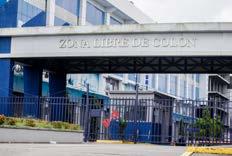
A total of 15 logistics parks currently operates throughout the country, most of which are located in the inter-oceanic zone. These are: Parque Logístico MIT, Parque Industrial y Comercial Costa del Este, Parque Sur, Parque Logístico Panamá, Global Business Terminal, Parque Industrial de las Américas, Panama Distribution Center, Parque Industrial Corredor Norte Milla 8, Parque Logístico Vacamonte y Ofibodegas, además del Panama Viejo Business Center, PANAWEST Centro Logístico, Tocumen Commercial Park, Tocumen Storage Complex, and Zona Uno Terminal Industrial.
INVESTMENT REGIMES OVERVIEW
Panama, with the establishment of different laws and regulations for local and foreign investors, has managed to promote the creation of companies with the objective of developing different types of activities and promoting international trade, manufacturing production and complementary services.
45 2023 - 2024 @Guialogisticapanama
FUENTE:
Panama
Georgia Tech
Distribution Center, Parque Industrial
Corredor Norte Milla 8, Parque Logístico Vacamonte y Ofibodegas, además del Panama Viejo Business Center, PANAWEST Centro Logístico, Tocumen Commercial Park, Tocumen Storage Complex y Zona Uno Terminal Industrial.
REGÍMENES DE INVERSIÓN
Panamá con el establecimiento de distintas leyes y regulaciones para inversores locales y extranjeros, ha logrado impulsar la creación de empresas con el objetivo de desarrollar diferentes tipos de actividades y promover el comercio internacional, la producción manufacturera y los servicios complementarios. A continuación algunos regímenes de inversión:
La Zona Libre de Colón es una zona de libre comercio cuyo objetivo es servir como plataforma para la redistribución de bienes al por mayor y libre de impuestos de Asia, Europa y América del Norte hacia América Latina y el Caribe. Localizada en el lado Atlántico del país, esta zona está apoyada por una amplia variedad de servicios logísticos y financieros que aprovechan su conectividad para ampliar el flujo de mercancía a los mercados regionales.
El Área Panamá Pacífico es un modelo de zona económica especial con el objetivo de ser un hub para la manufactura de alta tecnología, servicios logísticos, actividades comerciales y servicios no tradicionales, con un área residencial ecológicamente amigable. Un consorcio entre una agencia del Estado y un promotor privado, desarrolla un agresivo plan maestro que incluye áreas dedicadas para el almacenamiento y creación de centros de distribución, manufactura, oficinas comerciales, operaciones aeroportuarias y residenciales.
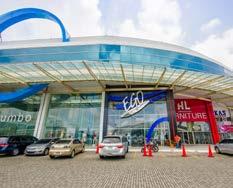
Las Zonas Francas panameñas cuentan con un régimen especial el cual contribuye con el desarrollo económico del país y promueve la inversión extranjera. Se definen como zonas delimitadas, dentro de las cuales
Here are some Investment Regimes:
Colón Free Zone is a free trade zone whose objective is to serve as a platform for redistributing wholesale and tax-exempted goods from Asia, Europe, and North America to Latin America and the Caribbean. Located on the Atlantic side of the country, it is supported by a variety of logistics and financial services that leverages its connectivity to improve the cargo flow to regional markets.
Panama Pacifico is a model of a special economic zone aiming to become a hub for high-tech manufacturing, logistics services, commercial activities, and non-traditional services, with an eco-friendly residential area. A joint consortium between a government agency and a private developer develops an aggressive master plan that includes dedicated areas for warehousing and distribution centers, manufacturing, commercial offices, airport operations, and residential.
Panamanian Free Zones have a special regime that contributes to the economic development of the country and promotes foreign investment. They are defined as delimited zones, within which all the infrastructures are developed, as well as the operative organization and the administrative management that are necessary so that they are established within them, companies
46 2023 - 2024 info@vallenardeditores.net +507 6326-3529
se desarrollan todas las infraestructuras, así como la organización operativa y la gestión administrativa que sean necesarias, para que se establezcan dentro de las mismas, empresas de todas partes del mundo cuyas actividades sean la producción de bienes, servicios, alta tecnología, investigación científica, servicios logísticos, servicios ambientales y servicios generales.
Ciudad del Saber es un complejo a cargo de la Fundación Ciudad del Saber, una organización creada en 1995 sin fines de lucro. Ciudad del Saber brinda incentivos fiscales y migratorios para sus usuarios que estén ubicados dentro del complejo y que se dediquen a la investigación e innovación en los campos científicos, tecnológicos humanísticos y cultural de transferencias de conocimiento para su uso en actividades productivas y de programas de educación superior de alta calidad.
Zona Franca Turística y de Apoyo Logístico Multimodal de Barú. Ofrece incentivos fiscales a una gama de actividades comerciales, turísticas, industriales y de servicios que se establezcan en dicha zona.
Sedes de Empresas Multinacionales y empresas bajo la ley EMMA. Otorga beneficios fiscales y migratorios para empresas que deseen establecerse en Panamá ya sea que ofrezcan servicios o manufactura.
The Colón Free Zone: Our first free
of all parts of the world whose activities are manufacturing, assembly, processing of finished or semi-finished products, services, high technology, higher education, health services, scientific research, logistics services, environmental services, and general services.
The City of Knowledge is a complex managed by the Ciudad del Saber Foundation, an organization created in 1995 for non-profit. Ciudad del Saber provides fiscal and migratory incentives for its users that are located within the complex and that are dedicated to research and innovation in the scientific and technological fields Humanistic and cultural transfer of knowledge for use in productive activities and high-quality programs of higher education.
Baru Free Zone. This zone offers tax incentives to a range of commercial, tourist, industrial, and service activities that are established in that area.
The Special System of Multinational Corporation Headquarters. It provides tax and migratory benefits for companies that wish to establish in Panama and offer services to their head office or subsidiaries.

47 2023 - 2024 @Guialogisticapanama
Zona Libre de Colón: nuestra primera zona franca.
trade zone.


" Creadores de conceptos editoriales " Editores de la Guía Logística/Logistics Guide " Traductores públicos autorizados Creadores de contenido con calidad de exportación, desde 2004. Creators of export-quality content since 2004. E-mail: info@vallenardeditores.net Tel.: +507-6326-3529
















































































